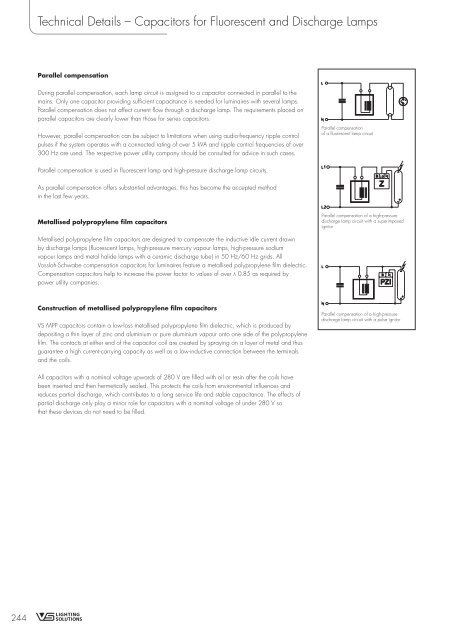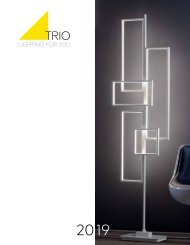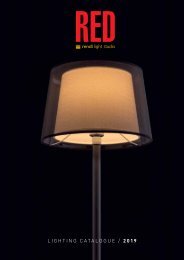- Page 1 and 2:
Component Systems for Lighting Appl
- Page 3 and 4:
Contents 5 Transformers for Low-vol
- Page 5 and 6:
1 PUMA Headquarters Porsche Museum
- Page 7 and 8:
2 Ballasts for Discharge Lamps For
- Page 9 and 10:
Ballasts for Discharge Lamps Electr
- Page 11 and 12:
Ballasts for Discharge Lamps Cord G
- Page 13 and 14:
Ballasts for Discharge Lamps Contro
- Page 15 and 16:
Ballasts for Discharge Lamps Contro
- Page 17 and 18:
Ballasts for Discharge Lamps Ballas
- Page 19 and 20:
Ballasts for Discharge Lamps Compac
- Page 21 and 22:
Ballasts for Discharge Lamps Standa
- Page 23 and 24:
Ballasts for Discharge Lamps Ballas
- Page 25 and 26:
Ballasts for Discharge Lamps Ballas
- Page 27 and 28:
Ballasts for Discharge Lamps Ballas
- Page 29 and 30:
Ballasts for Discharge Lamps Ballas
- Page 31 and 32:
Ballasts for Discharge Lamps Ballas
- Page 33 and 34:
Ballasts for Discharge Lamps Ballas
- Page 35 and 36:
Ballasts for Discharge Lamps Compac
- Page 37 and 38:
Ballasts for Discharge Lamps Ballas
- Page 39 and 40:
Ballasts for Discharge Lamps Ballas
- Page 41 and 42:
2 Ignitors and Accessories for Disc
- Page 43 and 44:
Ignitors and Accessories for Discha
- Page 45 and 46:
Ignitors and Accessories for Discha
- Page 47 and 48:
Ignitors and Accessories for Discha
- Page 49 and 50:
Ignitors and Accessories for Discha
- Page 51 and 52:
Ignitors and Accessories for Discha
- Page 53 and 54:
Ignitors and Accessories for Discha
- Page 55 and 56:
Ignitors and Accessories for Discha
- Page 57 and 58:
Ignitors and Accessories for Discha
- Page 59 and 60:
Ignitors and Accessories for Discha
- Page 61 and 62:
Ignitors and Accessories for Discha
- Page 63 and 64:
2 Lampholders for Discharge Lamps E
- Page 65 and 66:
Lampholders for Discharge Lamps E27
- Page 67 and 68:
Lampholders for Discharge Lamps E40
- Page 69 and 70:
Lampholders Fassungen für for Entl
- Page 71 and 72:
Lampholders for Discharge Lamps GY9
- Page 73 and 74:
Lampholders for Discharge Lamps Par
- Page 75 and 76:
Lampholders for Discharge Lamps RX7
- Page 77 and 78:
Lampholders for Discharge Lamps K12
- Page 79 and 80:
Technical Details - Components for
- Page 81 and 82:
Technical Details - Components for
- Page 83 and 84:
Technical Details - Components for
- Page 85 and 86:
Technical Details - Components for
- Page 87 and 88:
Technical Details - Components for
- Page 89 and 90:
Technical Details - Components for
- Page 91 and 92:
Technical Details - Components for
- Page 93 and 94:
Technical Details - Components for
- Page 95 and 96:
Technical Details - Components for
- Page 97 and 98:
Technical Details - Components for
- Page 99 and 100:
Technical Details - Components for
- Page 101 and 102:
Technical Details - Components for
- Page 103 and 104:
Technical Details - Components for
- Page 105 and 106:
Technical Details - Components for
- Page 107 and 108:
Technical Details - Components for
- Page 109 and 110:
Technical Details - Components for
- Page 111 and 112:
Technical Details - Components for
- Page 113 and 114:
Technical Details - Components for
- Page 115 and 116:
Technical Details - Components for
- Page 117 and 118:
Technical Details - Components for
- Page 119 and 120:
Technical Details - Components for
- Page 121 and 122:
3 Electronic Ballasts for TC and T
- Page 123 and 124:
Electronic Ballasts for TC and T La
- Page 125 and 126:
Electronic Ballasts for TC and T La
- Page 127 and 128:
Electronic Ballasts for TC and T La
- Page 129 and 130:
Electronic Ballasts for TC and T La
- Page 131 and 132:
Electronic Ballasts for TC and T La
- Page 133 and 134:
Electronic Ballasts for TC and T La
- Page 135 and 136:
Electronic Ballasts for TC and T La
- Page 137 and 138:
Electronic Ballasts for TC and T La
- Page 139 and 140:
Electronic Ballasts for TC and T La
- Page 141 and 142:
Electronic Ballasts for TC and T La
- Page 143 and 144:
Electronic Ballasts for TC and T La
- Page 145 and 146:
Electronic Ballasts for TC and T La
- Page 147 and 148:
3 Electromagnetic Ballasts for TC a
- Page 149 and 150:
Electromagnetic Ballasts for TC and
- Page 151 and 152:
Electromagnetic Ballasts for TC and
- Page 153 and 154:
Electromagnetic Ballasts for TC and
- Page 155 and 156:
Electromagnetic Ballasts for TC and
- Page 157 and 158:
3 Lampholders and Accessories for T
- Page 159 and 160:
Lampholders and Accessories for TC
- Page 161 and 162:
Lampholders and Accessories for TC
- Page 163 and 164:
Lampholders and Accessories for TC
- Page 165 and 166:
Lampholders and Accessories for TC
- Page 167 and 168:
Lampholders and Accessories for TC
- Page 169 and 170:
Lampholders and Accessories for TC
- Page 171 and 172:
Lampholders and Accessories for TC
- Page 173 and 174:
3 Lampholders and Accessories for T
- Page 175 and 176:
Lampholders and Accessories for T L
- Page 177 and 178:
Lampholders and Accessories for T L
- Page 179 and 180:
Lampholders and Accessories for T L
- Page 181 and 182:
Lampholders and Accessories for T L
- Page 183 and 184:
Lampholders and Accessories for T L
- Page 185 and 186:
Lampholders and Accessories for T L
- Page 187 and 188:
Lampholders and Accessories for T L
- Page 189 and 190:
Lampholders and Accessories for T L
- Page 191 and 192:
Lampholders and Accessories for T L
- Page 193 and 194: Lampholders and Accessories for T L
- Page 195 and 196: Lampholders and Accessories for T L
- Page 197 and 198: Lampholders and Accessories for T L
- Page 199 and 200: 3 Starter Holders and Terminal Bloc
- Page 201 and 202: Starter Holders and Terminal Blocks
- Page 203 and 204: Starter Holders and Terminal Blocks
- Page 205 and 206: Starter Holders and Terminal Blocks
- Page 207 and 208: Starter Holders and Terminal Blocks
- Page 209 and 210: Technical Details - Components for
- Page 211 and 212: Technical Details - Components for
- Page 213 and 214: Technical Details - Components for
- Page 215 and 216: Technical Details - Components for
- Page 217 and 218: Technical Details - Components for
- Page 219 and 220: Technical Details - Components for
- Page 221 and 222: Technical Details - Components for
- Page 223 and 224: Technical Details - Components for
- Page 225 and 226: Technical Details - Components for
- Page 227 and 228: Technical Details - Components for
- Page 229 and 230: Technical Details - Components for
- Page 231 and 232: Technical Details - Components for
- Page 233 and 234: Technical Details - Components for
- Page 235 and 236: Technical Details - Components for
- Page 237 and 238: 4 Parallel Capacitors Parallel capa
- Page 239 and 240: Parallel Capacitors Parallel Connec
- Page 241 and 242: Parallel Capacitors Parallel Connec
- Page 243: Technical Details - Capacitors for
- Page 247 and 248: Technical Details - Capacitors for
- Page 249 and 250: Technical Details - Capacitors for
- Page 251 and 252: Technical Details - Capacitors for
- Page 253 and 254: 5 Transformers for Low-voltage Halo
- Page 255 and 256: Transformers for Low-voltage Haloge
- Page 257 and 258: Transformers for Low-voltage Haloge
- Page 259 and 260: 5 Lampholders for Halogen Incandesc
- Page 261 and 262: Lampholders for Halogen Incandescen
- Page 263 and 264: Lampholders for Halogen Incandescen
- Page 265 and 266: Lampholders for Halogen Incandescen
- Page 267 and 268: Lampholders for Halogen Incandescen
- Page 269 and 270: Lampholders for Halogen Incandescen
- Page 271 and 272: Lampholders for Halogen Incandescen
- Page 273 and 274: Lampholders for Halogen Incandescen
- Page 275 and 276: Lampholders for Halogen Incandescen
- Page 277 and 278: Lampholders for Halogen Incandescen
- Page 279 and 280: 5 Lampholders for General-service I
- Page 281 and 282: Lampholders for General-service Inc
- Page 283 and 284: Lampholders for General-service Inc
- Page 285 and 286: Lampholders for General-service Inc
- Page 287 and 288: Lampholders for General-service Inc
- Page 289 and 290: Lampholders for General-service Inc
- Page 291 and 292: Lampholders for General-service Inc
- Page 293 and 294: Lampholders for General-service Inc
- Page 295 and 296:
Lampholders for General-service Inc
- Page 297 and 298:
Lampholders for General-service Inc
- Page 299 and 300:
Lampholders for General-service Inc
- Page 301 and 302:
Lampholders for General-service Inc
- Page 303 and 304:
Lampholders for General-service Inc
- Page 305 and 306:
Lampholders for General-service Inc
- Page 307 and 308:
Lampholders for General-service Inc
- Page 309 and 310:
Lampholders for General-service Inc
- Page 311 and 312:
Lampholders for General-service Inc
- Page 313 and 314:
Lampholders for General-service Inc
- Page 315 and 316:
Technical Details - Components for
- Page 317 and 318:
Technical Details - Components for
- Page 319 and 320:
Technical Details - Components for
- Page 321 and 322:
Technical Details - Components for
- Page 323 and 324:
Technical Details - Components for
- Page 325 and 326:
Technical Details - Components for
- Page 327 and 328:
Technical Details - Components for
- Page 329 and 330:
6 Emergency Lighting Modules for TC
- Page 331 and 332:
Emergency Lighting Modules for TC a
- Page 333 and 334:
Technical Details - Emergency Light
- Page 335 and 336:
Technical Details - Emergency Light
- Page 337 and 338:
Technical Details - Emergency Light
- Page 339 and 340:
Technical Details - Emergency Light
- Page 341 and 342:
1 2 3 4 5 Energy Management & Contr
- Page 343 and 344:
Components for the UL Market GX10 L
- Page 345 and 346:
Components for the UL Market G13 Pu
- Page 347 and 348:
Components for the UL Market 1 2 3
- Page 349 and 350:
General Technical Details Product d
- Page 351 and 352:
General Technical Details The follo
- Page 353 and 354:
General Technical Details Protectio
- Page 355 and 356:
General Technical Details Protectio
- Page 357 and 358:
Glossary A A type, B type capacitor
- Page 359 and 360:
Glossary R Reference ballast Specia
- Page 361 and 362:
Reference Numbers Ref. No. Type Pag
- Page 363 and 364:
Reference Numbers Ref. No. Type Pag
- Page 365 and 366:
Reference Numbers Ref. No. Type Pag
- Page 367 and 368:
Reference Numbers Ref. No. Type Pag
- Page 369 and 370:
Reference Numbers Ref. No. Type Pag
- Page 371 and 372:
Reference Numbers Ref. No. Type Pag
- Page 373 and 374:
Subsidiaries Subsidiaries Adress Ph

















